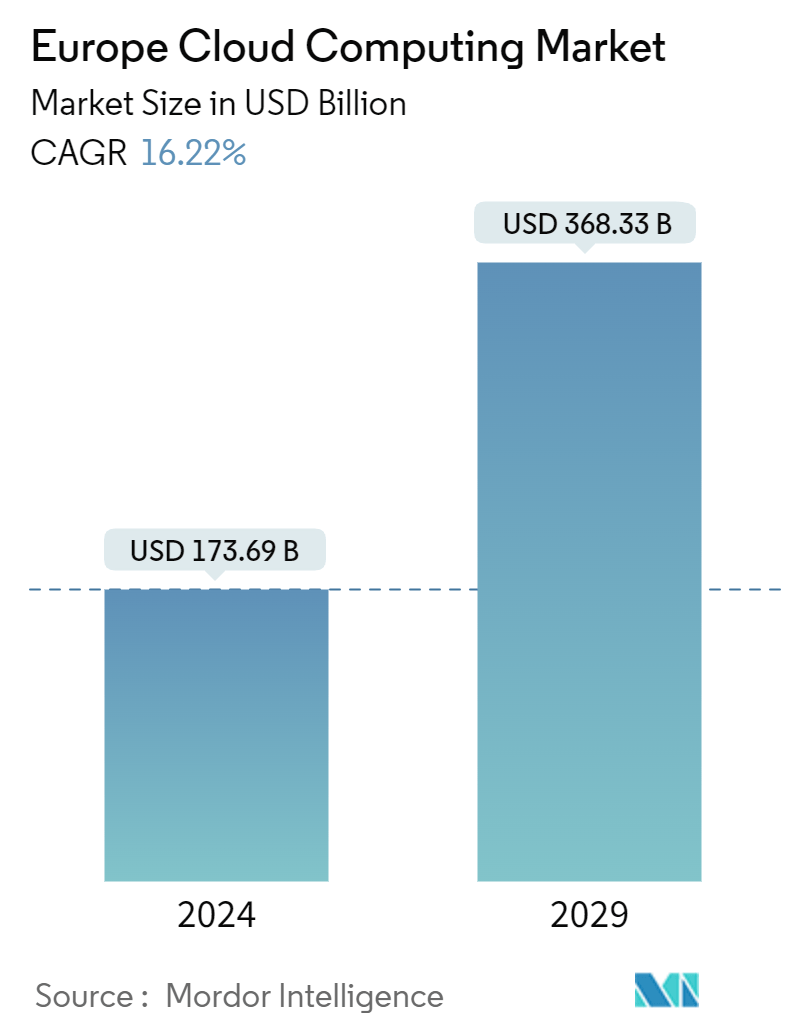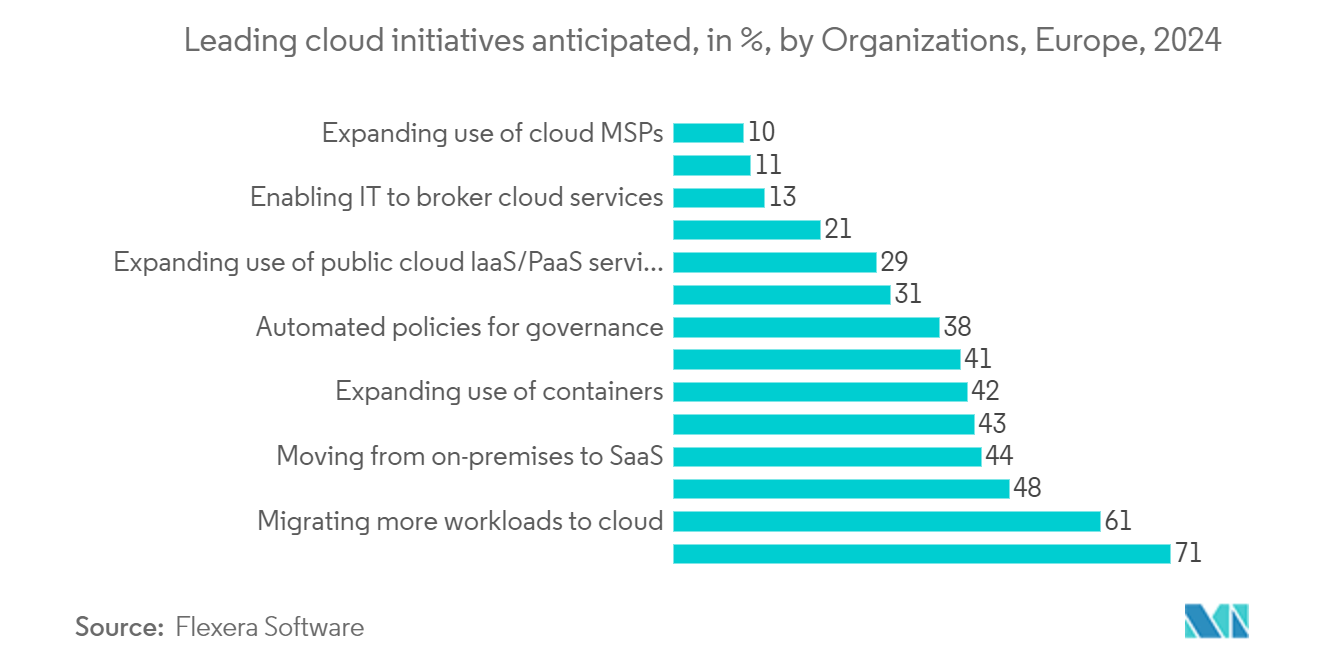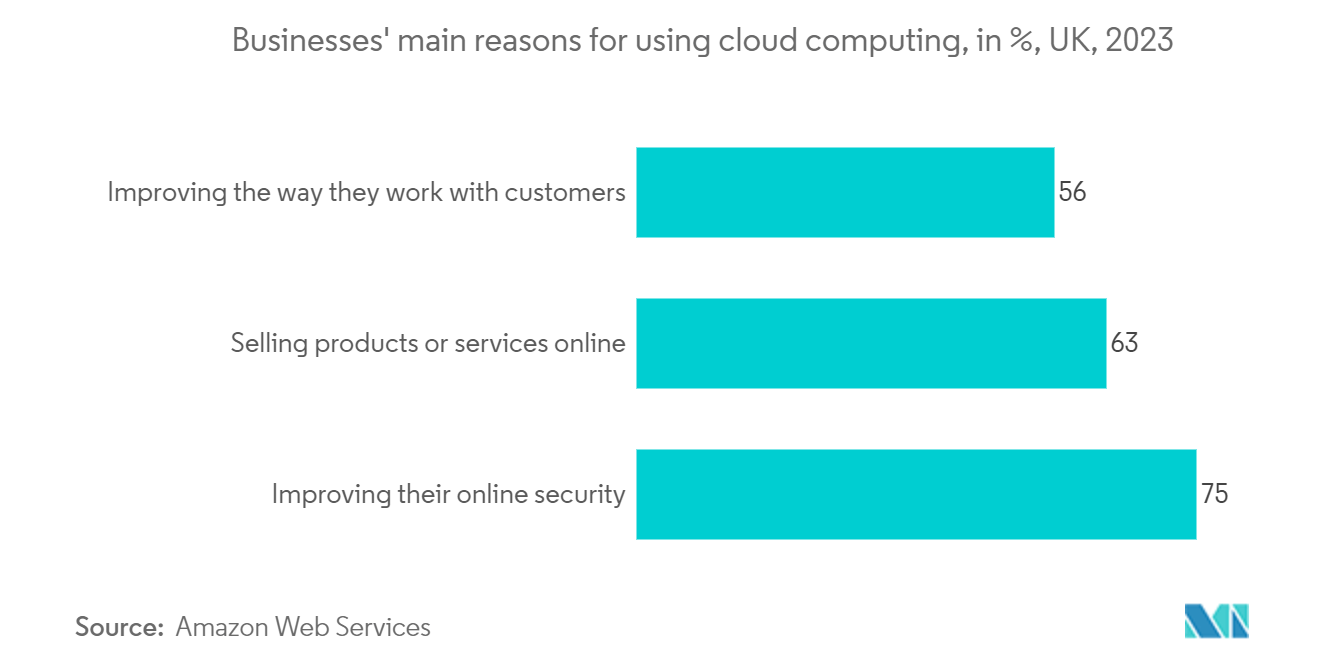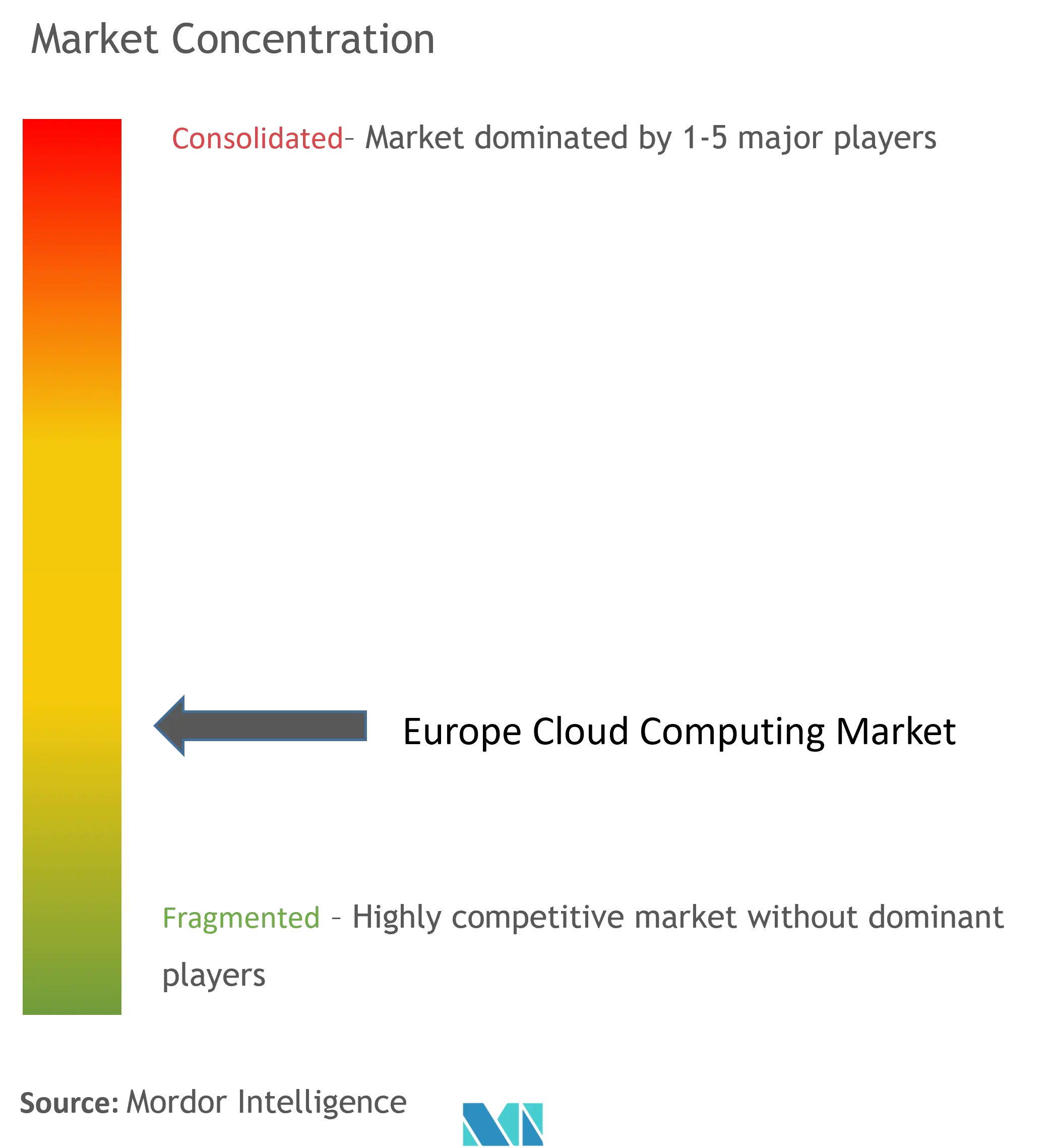Europe Cloud Computing Market Size

| Study Period | 2019 - 2029 |
| Base Year For Estimation | 2023 |
| Market Size (2024) | USD 173.69 Billion |
| Market Size (2029) | USD 368.33 Billion |
| CAGR (2024 - 2029) | 16.22 % |
| Market Concentration | Low |
Major Players
*Disclaimer: Major Players sorted in no particular order |
Europe Cloud Computing Market Analysis
The Europe Cloud Computing Market size is estimated at USD 173.69 billion in 2024, and is expected to reach USD 368.33 billion by 2029, growing at a CAGR of 16.22% during the forecast period (2024-2029).
The European cloud computing market has been experiencing significant growth, driven by rapid digital transformation across industries, increased adoption of cloud services, and the need for scalable and flexible IT infrastructure. European businesses and governments are increasingly leveraging cloud computing to enhance operational efficiency, ensure business continuity, and support innovation.
• As part of their digital transformation, European firms are swiftly integrating cloud computing. These cloud solutions empower businesses to modernize their IT setups, enhance customer experiences, and swiftly adapt to market shifts. Concurrently, European governments champion digital initiatives, further fueling the cloud's ascent.
• With an increasing emphasis on flexibility, data security, and regulatory compliance, hybrid and multi-cloud solutions are gaining traction in Europe. Organizations are strategically blending public and private cloud environments to optimize workloads, cut costs, and uphold data sovereignty.
• Investments in data center infrastructure are surging within the European cloud computing landscape. In response to escalating demand, major cloud service providers are broadening their data center footprint across Europe, emphasizing data localization and adherence to stringent regulations like GDPR.
• In the European cloud computing arena, sustainability is taking center stage. Cloud service providers are embracing green technologies and practices, aiming to shrink their carbon footprint. This movement resonates with Europe's overarching goal of net-zero emissions and sustainable business ethos.
• Despite the myriad advantages of cloud computing, Europe grapples with regulatory challenges and data sovereignty concerns. Navigating the intricate landscape of data protection regulations like GDPR, coupled with data residency and security apprehensions, presents hurdles for cloud service providers and their clientele, potentially dampening adoption in specific sectors.
• The growing strategic developments in the region are set to boost the market growth rate during the forecast period. In June 2024, Persistent Systems, a global leader in Digital Engineering and Enterprise Modernization, forged a long-term Strategic Partnership Agreement with Google Cloud. This collaboration aims to enhance their presence in the United States, India, the United Kingdom, and Australia. Central to this agreement is the joint go-to-market strategy, which seeks to expedite digital transformation for enterprises worldwide. Leveraging Google Cloud’s Gemini models and other cutting-edge technologies, Persistent Systems is set to craft tailored solutions, championing widespread GenAI adoption. Through this partnership, both Google Cloud and Persistent Systems are poised to offer top-tier solutions, ensuring enterprises modernize their infrastructure and data stack and optimize their ROI from cloud investments.
Europe Cloud Computing Market Trends
Strong Government support for Promoting Cloud Adoption
- European governments are prioritizing digital sovereignty, aiming to keep data generated in Europe stored and processed locally. This push fosters the growth of regional cloud infrastructure and diminishes dependence on non-European providers, championing the adoption of local cloud solutions.
- Governments are increasingly turning to cloud solutions to enhance public sector services, spanning healthcare, education, and administrative functions. This shift is fueling a surge in demand for cloud services, as public institutions aim to modernize their IT frameworks.
- For instance, Eurostat, a government agency, reports that cloud computing adoption in Europe rose by approximately 4% points from 2021 to 2023. By 2023, 45% of EU enterprises embraced cloud computing, with large enterprises showcasing a notably higher adoption rate. In 2023, Finland (78%), Sweden (72%), Norway (71%), and Denmark (70%) emerged as frontrunners in cloud adoption within the EU. Conversely, Bulgaria (18%), Romania (18%), and Greece (24%) recorded the lowest adoption rates.
- Organizations are increasingly adopting cloud solutions to meet the stringent data protection and privacy standards set by frameworks like the European Union's GDPR and the Digital Markets Act (DMA). This regulatory push is driving up the demand for cloud services that emphasize robust security and compliance features.
- Flexera Software, a US-based software company, reports that in 2024, 71% of European organizations prioritize optimizing their current cloud usage for cost savings and migrating additional workloads to the cloud. In addition, 61% of respondents view automated workload migration to the cloud as a significant priority for the year.

The UK is Expected to Hold a Major Share of the Market
- As one of the world's largest, the UK’s financial services sector has driven cloud adoption. Banks, insurance firms, and fintech companies are turning to cloud technologies, enhancing their data management, bolstering security, and elevating customer engagement, fueling the market's expansion.
- In November 2023, Aldermore Bank, a UK retail bank and lender, formed a strategic alliance with Mambu, a cloud banking platform. Aldermore Bank caters to homeowners, landlords, and business owners with financing solutions, alongside offering savings accounts and motor finance. Through this collaboration, Aldermore aims to modernize its technological approach, enhancing its clientele's unique experience. Mambu, a rapidly expanding SaaS cloud banking platform in the United Kingdom, accelerates the design and development of diverse financial offerings for a wide range of clients, including banks, lenders, fintechs, retailers, and telcos.
- In response to growing concerns, UK financial regulators are pushing for comprehensive new rules. These regulations aim to safeguard the UK's financial system from potential threats posed by cloud computing giants and other essential third parties that banks and insurers depend on. The Bank of England, highlighting the risks, seeks enhanced authority to oversee the finance industry's transition to cloud computing. Their concerns center around the industry's tendency toward secrecy and the concentration of sensitive data with major tech players, notably Amazon.com Inc. and Microsoft Corp.
- Post-Brexit, there has been an increased focus on data sovereignty and localization. This has led to a surge in demand for UK-based cloud providers that can ensure compliance with local data regulations, boosting the domestic cloud market. Post-Brexit, the United Kingdom rolled out its tailored version of GDPR, introducing notable changes that directly affected the daily operations of data centers and cloud service providers. This shift from the European norm has intensified scrutiny of consumer data management, mandating frequent audits and checks for compliance. As a result, data centers and cloud service providers have faced heightened costs to meet these compliance demands, ultimately impacting their profit margins.
- The growing developments in the country are set to bolster the market growth rate during the forecast period. In June 2024, UK Power Networks adopted cloud transformation. The London-based energy distributor and system operator is nearing the completion of a significant migration to a hybrid cloud infrastructure. This infrastructure is expected to cater to approximately one-third of all residents and businesses across the United Kingdom. UK Power Networks, primarily utilizing Microsoft Azure for its cloud requirements, will maintain on-premises systems in two data centers. These data centers are designated for storing highly sensitive data and services, ensuring protection against potential cyberattacks.

Europe Cloud Computing Industry Overview
The European cloud computing market is fragmented, with major players like Amazon Web Services, Google LLC, etc. Players in the market are adopting strategies such as partnerships and acquisitions to enhance their product offerings and gain sustainable competitive advantage.
Europe Cloud Computing Market Leaders
-
Alibaba Group Holding Limited
-
Amazon Web Services (AWS)
-
Google LLC
-
IBM Corporation
-
Microsoft Corporation
*Disclaimer: Major Players sorted in no particular order

Europe Cloud Computing Market News
- February 2024 - Admiral, a subsidiary of the Admiral Group, a British financial services firm, chose Google Cloud as its strategic cloud partner. As per the agreement, Google Cloud will power Admiral's core insurance operations, which include insurance policy administration and digital systems. Admiral plans to leverage Google Cloud technologies to innovate new digital products and services, notably enhancing its customer-facing mobile app. This partnership is expected to allow Admiral to speed up the launch of new products and services by utilizing containerized cloud applications and embracing modern software development practices. With Google Cloud’s data analytics capabilities, Admiral aims to boost operational efficiency and enhance customer service through AI and machine learning services.
- January 2024 - Vodafone and Microsoft Corp. unveiled a significant 10-year strategic partnership. This collaboration aims to harness their combined strengths, delivering expansive digital platforms to over 300 million businesses, public sector entities, and consumers throughout Europe and Africa. As part of the alliance, Vodafone is set to channel a USD 1.5 billion investment over the next decade, focusing on cloud services and AI solutions tailored for customers, all co-developed with Microsoft.
Europe Cloud Computing Market Report - Table of Contents
1. INTRODUCTION
- 1.1 Study Assumptions and Market Definition
- 1.2 Scope of the Study
2. RESEARCH METHODOLOGY
3. EXECUTIVE SUMMARY
4. MARKET INSIGHTS
- 4.1 Market Overview
-
4.2 Industry Attractiveness - Porter's Five Forces Analysis
- 4.2.1 Bargaining Power of Suppliers
- 4.2.2 Bargaining Power of Buyers
- 4.2.3 Threat of New Entrants
- 4.2.4 Threat of Substitutes
- 4.2.5 Intensity of Competitive Rivalry
- 4.3 Industry Regulations and Standards
- 4.4 Number of Data Centers by Country
- 4.5 Case Study Analysis
- 4.6 Technology Landscape
5. MARKET DYNAMICS
-
5.1 Market Drivers
- 5.1.1 Strong Government Support for Promoting Cloud Adoption
- 5.1.2 Presence of Numerous Cloud Data Centers in the European Region
-
5.2 Market Challenges
- 5.2.1 Threat of Data Breaches and Cyberattacks
- 5.3 Pricing Model Analysis
6. MARKET SEGMENTATION
-
6.1 By Type
- 6.1.1 Public Cloud
- 6.1.1.1 IaaS
- 6.1.1.2 PaaS
- 6.1.1.3 SaaS
- 6.1.2 Private Cloud
- 6.1.3 Hybrid Cloud
-
6.2 Organization Size
- 6.2.1 SMEs
- 6.2.2 Large Enterprises
-
6.3 End-user Industries
- 6.3.1 Manufacturing
- 6.3.2 Education
- 6.3.3 Retail
- 6.3.4 Transportation and Logistics
- 6.3.5 Healthcare
- 6.3.6 BFSI
- 6.3.7 Telecom and IT
- 6.3.8 Government and Public Sector
- 6.3.9 Other End-user Industries (Utilities, Media & Entertainment, etc.)
-
6.4 Country
- 6.4.1 United Kingdom
- 6.4.2 Germany
- 6.4.3 France
- 6.4.4 Italy
- 6.4.5 Rest of Europe
7. COMPETITIVE LANDSCAPE
-
7.1 Company Profiles*
- 7.1.1 Alibaba Group Holding Limited
- 7.1.2 Amazon Web Services (AWS)
- 7.1.3 Google LLC
- 7.1.4 IBM Corporation
- 7.1.5 Microsoft Corporation
- 7.1.6 Salesforce.com Inc.
- 7.1.7 SAP SE
8. INVESTMENT ANALYSIS
9. FUTURE MARKET OUTLOOK
** Subject To AvailablityEurope Cloud Computing Industry Segmentation
Cloud computing provides on-demand access to computer resources, particularly data storage and processing power, without requiring direct management by the user. Computing resources, including physical and virtual servers, data storage, networking capabilities, application development tools, software, and AI-powered analytics, are accessible over the Internet with a pay-per-use pricing model.
The report covers European cloud computing companies, and the market is segmented by type (public cloud, private cloud, and hybrid cloud), organization type (SMEs and large enterprises), end-user industries (manufacturing, education, retail, transportation, and logistics, healthcare, BFSI, telecom, and IT, government and public sector), and country (the United Kingdom, Germany, France, Italy, and the Rest of Europe). The market sizes and forecasts are provided in terms of value (USD) for all the above segments.
| By Type | Public Cloud | IaaS |
| PaaS | ||
| SaaS | ||
| By Type | Private Cloud | |
| Hybrid Cloud | ||
| Organization Size | SMEs | |
| Large Enterprises | ||
| End-user Industries | Manufacturing | |
| Education | ||
| Retail | ||
| Transportation and Logistics | ||
| Healthcare | ||
| BFSI | ||
| Telecom and IT | ||
| Government and Public Sector | ||
| Other End-user Industries (Utilities, Media & Entertainment, etc.) | ||
| Country | United Kingdom | |
| Germany | ||
| France | ||
| Italy | ||
| Rest of Europe |
Europe Cloud Computing Market Research FAQs
How big is the Europe Cloud Computing Market?
The Europe Cloud Computing Market size is expected to reach USD 173.69 billion in 2024 and grow at a CAGR of 16.22% to reach USD 368.33 billion by 2029.
What is the current Europe Cloud Computing Market size?
In 2024, the Europe Cloud Computing Market size is expected to reach USD 173.69 billion.
Who are the key players in Europe Cloud Computing Market?
Alibaba Group Holding Limited, Amazon Web Services (AWS), Google LLC, IBM Corporation and Microsoft Corporation are the major companies operating in the Europe Cloud Computing Market.
What years does this Europe Cloud Computing Market cover, and what was the market size in 2023?
In 2023, the Europe Cloud Computing Market size was estimated at USD 145.52 billion. The report covers the Europe Cloud Computing Market historical market size for years: 2019, 2020, 2021, 2022 and 2023. The report also forecasts the Europe Cloud Computing Market size for years: 2024, 2025, 2026, 2027, 2028 and 2029.
Europe Cloud Computing Industry Report
Statistics for the 2024 Europe Cloud Computing market share, size and revenue growth rate, created by Mordor Intelligence™ Industry Reports. Europe Cloud Computing analysis includes a market forecast outlook for 2024 to 2029 and historical overview. Get a sample of this industry analysis as a free report PDF download.



